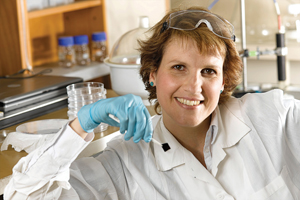The Technion researchers drilled tiny, nanometer-sized pores in silicon in an electrochemical reaction. This perforated chip has a characteristic optical imprint in the visible light range and a special polymer is used as an arm to bind specific antibodies to the bacteria and thus capture them

The accepted method today for identifying and monitoring bacteria in water is carried out by sampling in the field and sending the samples for analysis in a microbiological laboratory. The identification and quantification of contamination in the laboratory is indeed accurate, but it requires a lot of time (between two days and a week), skilled personnel, and sometimes also the use of complex and expensive laboratory equipment.
In the laboratory of Dr. Ester Segal from the Faculty of Biotechnology and Food Engineering at the Technion, an advanced silicon chip is being developed that allows to identify and quantify the bacterial contamination within minutes already in the field and without the need to send samples to the laboratory. The Technion researchers drilled tiny, nanometer-sized pores in silicon in an electrochemical reaction. "This perforated chip has a characteristic optical imprint in the visible light range," explains Dr. Segal. "We bind to it a special polymer, which we also developed in our laboratories, and it is used as an arm to bind specific antibodies to the bacteria. This special structure traps the bacteria on the surface of the silicone. The 'trapped' bacteria cause a change in the light spectrum reflected from the chip, and this is how we detect them. A signal sent from the computerized optical system can warn in real time about the bacterial contamination."
A possible application of the chip developed by Dr. Segal from the Technion, together with doctoral student Naama Mesad-Ivnir and master's student Giorgi Stenberg, is in the establishment of an infrastructure for immediate warning of infections. Moreover - the message will not be general but will provide immediate information about the type of infection. This is an extremely effective method for combating biological terrorism but also for detecting contamination in drinking water, food and the environment.

3 תגובות
Hello Dr. Esther Segal:
I am a consultant to the Water Authority on water quality security.
I would like to contact you regarding the research you are conducting.
My phone numbers are:
09-7654714
050-8698081
my mail: ysack@bezeqint.net
In gratitude and many thanks
Jacob Zak
Well done Elena!!! All the days in the lab paid off
Nice idea
I assume that the library of bacteria represented on the chip is relatively small and limited to the main pathogens and of those that have specific antibodies. Moreover, I also assume that the specific antibodies can also capture a non-specific pollutant in a complex and open environment, but at the very least such a chip can give an initial indication and a quick red light in case of suspicion.
Greetings friends,
Ami Bachar